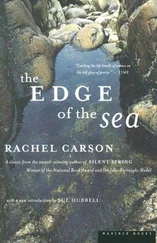The Clear Lake situation brings up a question that the public needs to face: Is it wise or desirable to use substances with such strong effect on physiological processes for the control of insects, especially when the control measures involve introducing the chemical directly into a body of water? The fact that the insecticide was applied in very low concentrations is meaningless, as its explosive progress through the natural food chain in the lake demonstrates. Yet Clear Lake is typical of a large and growing number of situations where solution of an obvious and often trivial problem creates a far more serious but conveniently less tangible one. Here the problem was resolved in favor of those annoyed by gnats, and at the expense of an unstated, and probably not even clearly understood, risk to all who took food or water from the lake.
It is an extraordinary fact that the deliberate introduction of poisons into a reservoir is becoming a fairly common practice. The purpose is usually to promote recreational uses, even though the water must then be treated at some expense to make it fit for its intended use as drinking water. When sportsmen of an area want to “improve” fishing in a reservoir, they prevail on authorities to dump quantities of poison into it to kill the undesired fish, which are then replaced with hatchery fish more suited to the sportsmen’s taste. The procedure has a strange, Alice-in-Wonderland quality. The reservoir was created as a public water supply, yet the community, probably unconsulted about the sportsmen’s project, is forced either to drink water containing poisonous residues or to pay out tax money for treatment of the water to remove the poisons—treatments that are by no means foolproof.
As ground and surface waters are contaminated with pesticides and other chemicals, there is danger that not only poisonous but also cancer-producing substances are being introduced into public water supplies. Dr. W. C. Hueper of the National Cancer Institute has warned that “the danger of cancer hazards from the consumption of contaminated drinking water will grow considerably within the foreseeable future.” And indeed a study made in Holland in the early 1950’s provides support for the view that polluted waterways may carry a cancer hazard. Cities receiving their drinking water from rivers had a higher death rate from cancer than did those whose water came from sources presumably less susceptible to pollution such as wells. Arsenic, the environmental substance most clearly established as causing cancer in man, is involved in two historic cases in which polluted water supplies caused widespread occurrence of cancer. In one case the arsenic came from the slag heaps of mining operations, in the other from rock with a high natural content of arsenic. These conditions may easily be duplicated as a result of heavy applications of arsenical insecticides. The soil in such areas becomes poisoned. Rains then carry pan of the arsenic into streams, rivers, and reservoirs, as well as into the vast subterranean seas of groundwater.
Here again we are reminded that in nature nothing exists alone. To understand more clearly how the pollution of our world is happening, we must now look at another of the earth’s basic resources, the soil.

THE THIN LAYER of soil that forms a patchy covering over the continents controls our own existence and that of every other animal of the land. Without soil, land plants as we know them could not grow, and without plants no animals could survive.
Yet if our agriculture-based life depends on the soil, it is equally true that soil depends on life, its very origins and the maintenance of its true nature being intimately related to living plants and animals. For soil is in part a creation of life, born of a marvelous interaction of life and nonlife long eons ago. The parent materials were gathered together as volcanoes poured them out in fiery streams, as waters running over the bare rocks of the continents wore away even the hardest granite, and as the chisels of frost and ice split and shattered the rocks. Then living things began to work their creative magic and little by little these inert materials became soil. Lichens, the rocks’ first covering, aided the process of disintegration by their acid secretions and made a lodging place for other life. Mosses took hold in the little pockets of simple soil—soil formed by crumbling bits of lichen, by the husks of minute insect life, by the debris of a fauna beginning its emergence from the sea.
Life not only formed the soil, but other living things of incredible abundance and diversity now exist within it; if this were not so the soil would be a dead and sterile thing. By their presence and by their activities the myriad organisms of the soil make it capable of supporting the earth’s green mantle.
The soil exists in a state of constant change, taking part in cycles that have no beginning and no end. New materials are constantly being contributed as rocks disintegrate, as organic matter decays and as nitrogen and other gases are brought down in rain from the skies. At the same time other materials are being taken away, borrowed for temporary use by living creatures. Subtle and vastly important chemical changes are constantly in progress, converting elements derived from air and water into forms suitable for use by plants. In all these changes living organisms are active agents.
There are few studies more fascinating, and at the same time more neglected, than those of the teeming populations that exist in the dark realms of the soil. We know too little of the threads that bind the soil organisms to each other and to their world, and to the world above.
Perhaps the most essential organisms in the soil are the smallest—the invisible hosts of bacteria and of threadlike fungi. Statistics of their abundance take us at once into astronomical figures. A teaspoonful of topsoil may contain billions of bacteria. In spite of their minute size, the total weight of this host of bacteria in the top foot of a single acre of fertile soil may be as much as a thousand pounds. Ray fungi, growing in long threadlike filaments, are somewhat less numerous than the bacteria, yet because they are larger their total weight in a given amount of soil may be about the same. With small green cells called algae, these make up the microscopic plant life of the soil.
Bacteria, fungi, and algae are the principal agents of decay, reducing plant and animal residues to their component minerals. The vast cyclic movements of chemical elements such as carbon and nitrogen through soil and air and living tissue could not proceed without these microplants. Without the nitrogen-fixing bacteria, for example, plants would starve for want of nitrogen, though surrounded by a sea of nitrogen-containing air. Other organisms form carbon dioxide, which, as carbonic acid, aids in dissolving rock. Still other soil microbes perform various oxidations and reductions by which minerals such as iron, manganese, and sulfur are transformed and made available to plants.
Also present in prodigious numbers are microscopic mites and primitive wingless insects called springtails. Despite their small size they play an important part in breaking down the residues of plants, aiding in the slow conversion of the litter of the forest floor to soil. The specialization of some of these minute creatures for their task is almost incredible. Several species of mites, for example, can begin life only within the fallen needles of a spruce tree. Sheltered here, they digest out the inner tissues of the needle. When the mites have completed their development only the outer layer of cells remains. The truly staggering task of dealing with the tremendous amount of plant material in the annual leaf fall belongs to some of the small insects of the soil and the forest floor. They macerate and digest the leaves, and aid in mixing the decomposed matter with the surface soil.
Читать дальше













